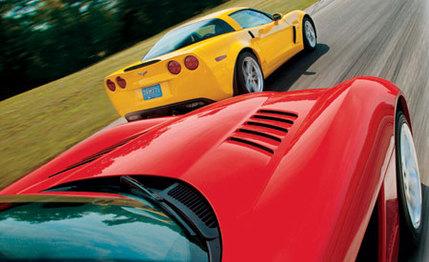
 Comparison Tests
Comparison Tests
A three o'clock schoolyard showdown between these two Motor City bullies wasn't a question of if, but rather when. For a time, the Viper and the wickedest of the Corvette line, the Z06, kept their distance because there were major differences between the two. The Viper was an 85K roadster, the Z06 a 53K coupe. Sure, some mags compared the two, but the cars were just too different to make an even fight.
But now these two inhabit the same turf. The current-generation Viper has just been released with the option of a fixed hardtop. It's still a 510-hp, V-10-powered bruiser, but now its structure is a little stiffer, thanks to that fixed roof. It looks outrageous, fantastic even, and carries a big sticker of $86,995.
On paper, the Corvette Z06, which is built only as a coupe, is the early favorite. Although its pony count of 505 is nearly identical to the Viper's, the Z06 has critical advantages. Its greatest strength is its weight or, more specifically, the lack thereof. Corvette engineers went banzai turning a standard Vette into the Z06. Although they added heavier brakes, wheels, tires, and other parts to handle the more powerful engine (the standard Vette makes 105 fewer horses), the Z06 also went through an intense weight-reduction program.
The frame of the standard Corvette is made of steel, and the Z06's is constructed of aluminum (it doesn't weigh 136 pounds, as we mistakenly reported in our October 2005 issue, but is 136 pounds lighter than the steel one). Lightweight magnesium castings are used for the engine cradle and roof structure; the front fenders are made from carbon fiber; the engine's connecting rods and intake valves are titanium. The Z06 you see here weighs 3147 pounds, which is 323 less than the Viper's heft. Yes, the Viper's 535 pound-feet of torque work out to 65 more than the Corvette's, but usually the horsepower-to-weight ratio (6.2 pounds per horsepower for the Vette handily beats the Viper's 6.8) determines speed. To cap it off, the Z06's base price is just $65,800, which makes it the least-expensive 500-hp production car on the market.
We're all used to the notion that you get what you pay for. So what, if anything, did the Corvette crew leave out to whittle down the Z06's price? Or what does the Viper provide for the extra $21,195?
We should pause here for a moment and mention the elephant in the room, namely, the other Detroit powerhouse, the Ford GT. We know from previous experience that in terms of performance it's at least the equal of, and in some cases the better of, these two. Some might say that it deserves to be in this fight, but not at $153,345. When was the last time you were shopping for two cars and one cost more than double the other? Yeah, we know, never.
We put the Viper and the Z06 through a 700-mile grind that included our usual battery of performance tests, lapping at the undulating thrill ride of a 2.0-mile racetrack called Grattan Raceway Park, then on to a few hours of southern-Ohio back roads, not to mention a good deal of highway slogging.
We ran this test side by side with another comparison, between the Mazda MX-5 and Pontiac Solstice. It was an insightful experience. We've always assumed that road inhalers like the Viper and Vette quickly lose their luster when they're not out on a track generating numbers. And we proved it. Both of these bruisers are about eight inches wider than the Miata, and those eight inches take up every bit of available back-road run-off room. So we ended up driving the big dogs at far below their potential, realizing that full speed in these cars would have posed too great a risk for innocents in the vicinity. Sure, you could push it, but then you'd be a jackass that we wouldn't care to know.
At the track, though, the brutes provided a greater level of fun and challenges than the little guys. The cornering and straight-line speeds are faster, and that in itself is a kick. Also, the Miata and the Solstice are underpowered enough that in most cases, any time you're on the gas, you have the throttles pinned to the floor. It's the opposite for the 500-hp cars, where sloppy throttle work will send you spinning. Both are fun, but getting the most out of the fast cars simply takes more concentration, so when you get it right, you thump your chest a little harder.
Okay, the bell has rung, it's three o'clock, and a crowd has formed. Let's see who's the toughest on the playground.